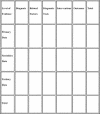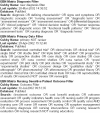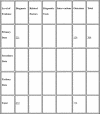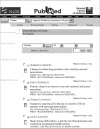Development and evaluation of evidence-based nursing (EBN) filters and related databases
- PMID: 15685282
- PMCID: PMC545129
Development and evaluation of evidence-based nursing (EBN) filters and related databases
Abstract
Objectives: Difficulties encountered in the retrieval of evidence-based nursing (EBN) literature and recognition of terminology, research focus, and design differences between evidence-based medicine and nursing led to the realization that nursing needs its own filter strategies for evidence-based practice. This article describes the development and evaluation of filters that facilitate evidence-based nursing searches.
Methods: An inductive, multistep methodology was employed. A sleep search strategy was developed for uniform application to all filters for filter development and evaluation purposes. An EBN matrix was next developed as a framework to illustrate conceptually the placement of nursing-sensitive filters along two axes: horizontally, an adapted nursing process, and vertically, levels of evidence. Nursing diagnosis, patient outcomes, and primary data filters were developed recursively. Through an interface with the PubMed search engine, the EBN matrix filters were inserted into a database that executes filter searches, retrieves citations, and stores and updates retrieved citations sets hourly. For evaluation purposes, the filters were subjected to sensitivity and specificity analyses and retrieval set comparisons. Once the evaluation was complete, hyperlinks providing access to any one or a combination of completed filters to the EBN matrix were created. Subject searches on any topic may be applied to the filters, which interface with PubMed.
Results: Sensitivity and specificity for the combined nursing diagnosis and primary data filter were 64% and 99%, respectively; for the patient outcomes filter, the results were 75% and 71%, respectively. Comparisons were made between the EBN matrix filters (nursing diagnosis and primary data) and PubMed's Clinical Queries (diagnosis and sensitivity) filters. Additional comparisons examined publication types and indexing differences. Review articles accounted for the majority of the publication type differences, because "review" was accepted by the CQ but was "NOT'd" by the EBN filter. Indexing comparisons revealed that although the term "nursing diagnosis" is in Medical Subject Headings (MeSH), the nursing diagnoses themselves (e.g., sleep deprivation, disturbed sleep pattern) are not indexed as nursing diagnoses. As a result, abstracts deemed to be appropriate nursing diagnosis by the EBN filter were not accepted by the CQ diagnosis filter.
Conclusions: The EBN filter capture of desired articles may be enhanced by further refinement to achieve a greater degree of filter sensitivity. Retrieval set comparisons revealed publication type differences and indexing issues. The EBN matrix filter "NOT'd" out "review," while the CQ filter did not. Indexing issues were identified that explained the retrieval of articles deemed appropriate by the EBN filter matrix but not included in the CQ retrieval. These results have MeSH definition and indexing implications as well as implications for clinical decision support in nursing practice.
Figures




Similar articles
-
Development of two search strategies for literature in MEDLINE-PubMed: nursing diagnoses in the context of evidence-based nursing.Int J Nurs Terminol Classif. 2005 Apr-Jun;16(2):26-32. doi: 10.1111/j.1744-618X.2005.00006.x. Int J Nurs Terminol Classif. 2005. PMID: 16045550
-
Research methodology search filters: are they effective for locating research for evidence-based veterinary medicine in PubMed?J Med Libr Assoc. 2003 Oct;91(4):484-9. J Med Libr Assoc. 2003. PMID: 14566380 Free PMC article.
-
OvidSP Medline-to-PubMed search filter translation: a methodology for extending search filter range to include PubMed's unique content.BMC Med Res Methodol. 2013 Jul 2;13:86. doi: 10.1186/1471-2288-13-86. BMC Med Res Methodol. 2013. PMID: 23819658 Free PMC article.
-
Evaluation of methodological search filters--a review.Health Info Libr J. 2004 Sep;21(3):148-63. doi: 10.1111/j.1471-1842.2004.00511.x. Health Info Libr J. 2004. PMID: 15318913 Review.
-
Literature search using PubMed: an essential tool for practicing evidence- based medicine.J Assoc Physicians India. 2006 Apr;54:303-8. J Assoc Physicians India. 2006. PMID: 16944614 Review.
Cited by
-
What lies behind the wish to hasten death? A systematic review and meta-ethnography from the perspective of patients.PLoS One. 2012;7(5):e37117. doi: 10.1371/journal.pone.0037117. Epub 2012 May 14. PLoS One. 2012. PMID: 22606338 Free PMC article. Review.
-
Limits of search filter development.J Med Libr Assoc. 2016 Jan;104(1):42-6. doi: 10.3163/1536-5050.104.1.006. J Med Libr Assoc. 2016. PMID: 26807051 Free PMC article.
-
The Application of Clinical Nursing Pathway in the Classification Diagnosis and Treatment of Patients with Emergency Dyspnea.Iran J Public Health. 2017 Apr;46(4):574-576. Iran J Public Health. 2017. PMID: 28540278 Free PMC article. No abstract available.
References
-
- University of Toronto Libraries, Centre for Evidence-Based Medicine. Practising EBM. [Web document]. 2004. [cited 22 May 2004]. <http://www.cebm.utoronto.ca/practise/>.
-
- Jenicek M. Clinical case reporting in evidence-based medicine. New York, NY: Oxford University Press, 2001.
-
- McKibbon KA, Eady A, and Marks S. PDQ: evidence-based principles and practice. Hamilton, ON, Canada: B. C. Decker, 1999.
-
- National Library of Medicine. PubMed's Clinical Queries research methodology filters. [Web document]. [cited 22 May 2004]. <http://www.ncbi.nlm.nih.gov/entrez/query/static/clinicaltable.html>.
-
- Haynes RB, Wilczynski NL. (Hedges Team). Optimal search strategies for retrieving scientifically strong studies of diagnosis from Medline: analytical survey. [Web document]. BMJ 2004;328(7447). Available from: <http://bmj.bmjjournals.com/cgi/content/full/328/7447/1040>. [cited 11 May 2004]. - PMC - PubMed
Publication types
MeSH terms
LinkOut - more resources
Full Text Sources
Research Materials
